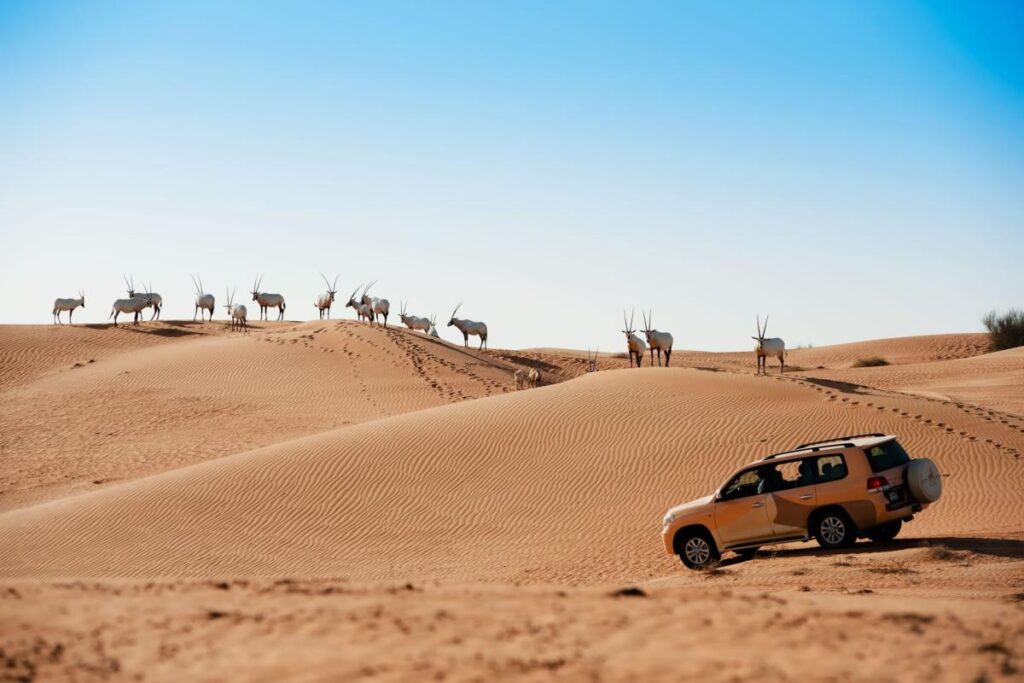Dubai is a city of epic aesthetics, with towering architecture, dancing fountains, luxury hotels and multi-million pound yachts. But delve a little deeper and the real delights of this UAE city come into view. The old quarter is packed with spice souks and galleries, while the newer districts promise authentic Emirati cuisine and crafts, plus surf schools and supper clubs.
There’s adventure on the horizon, too. Beyond the city limits, Dubai is the country’s second-largest emirate: a surprisingly unspoiled region where activities range from desert safaris among wild Arabian oryx in the Dubai Desert Conservation Reserve to mountain biking in the Hajar Peaks of Hatta. Whether it’s a quick stopover or a final destination, here’s how to explore Dubai like a local.
First-time visitors should head straight to the city’s big hits in the Downtown area. Here, travelers can look out over the city from the Burj Khalifa‘s 124th floor observation deck, treat yourself to Dubai shopping mall‘s huge range of international brands and then marvel at the dancing fountains of Dubai.
Now that the tourist hotspots have faded, Dubai’s lesser-known corners, like its thriving Old Quarter, should be next on the list. Centuries before oil was discovered in the 1970s, traders from across the Middle East and Asia would dock at Dubai Creek — now known as “Old Dubai” — to ply their wares in the waterfront souks. Today, travelers can still buy everything from Kashmiri chili to Iranian saffron at Deira’s Spice Souk and Gold Souk (there are plenty of stalls, but Zafaran Isfahan is high quality and hassle-free) to 24 carat tiaras suitable for a sheikah. While it’s easy to explore independently, consider a private walking tour with Nada Badran — aka Walk with NadaHer souk knowledge is superb, whether she’s searching for sequined Indian saris or the juiciest Medjool dates.
Alserkal’s independent boutiques also offer a great alternative to the busy malls in Downtown. Once an industrial area in the heart of Dubai, Alserkal now consists of around 40 trendy warehouses that have been converted into art galleries, dance studios, artisan cafes and more. Top spots here include intricate calligraphy at El Seed and fragrant Omani incense from House EtheriqueThe historic Al Fahidi district, formerly known as the Bastakiya quarter, is another restored heritage area, where maze-like streets and old pearl merchants’ houses now house several museums, craft shops, cultural exhibitions, courtyard cafes and galleries. XVA Gallery is a local favorite for its UAE-designed jewelry and affordable prints. While you’re in the area, visit Sheikh Mohammed Centre for Cultural Understanding (SMCCU) where fun incense making workshops and informative tours of the Jumeirah Mosque are organized.
Over 200 nationalities call Dubai home, which has resulted in an incredibly diverse culinary offering — ranging from budget bites to haute cuisine. For relaxed, Michelin-starred dining, head to the recently crowned Moonrise in Satwa, which serves Arabic-Japanese teppanyaki to just 12 guests at a time. In the same area, Ravi is is a local choice for budget-friendly Pakistani curries and street-style pakoras, while Al Khayma Heritage Restaurant in Al Fahidi specializes in Emirati cuisine. The cooking classes share generations-old recipes for chicken biryani style machangryand viscous to air dumplings.
For a more personal, cultural experience, join a supper club to break bread with locals in their own homes, swap stories and sample dishes from across the Middle East and beyond. Top tables include Kunwal Safdar’s Meerish by K — for UAE and Persian mezze served in her own kitchen — and vegan Venezuelan dishes at Table by Kiki Alvarez, the chef behind the award-winning garden bistro SEVA tablea great backup if Mesa is sold out. Search and book supper clubs via Split.
For beach lovers, Dubai’s long, linear layout hugs the coast, with spots like Kite Beach and Palm West Beach combining golden sand, gentle waves and sea breezes. These beaches not only offer ideal conditions for sunbathing, but also for Dubai’s emerging surfing scene. For lessons and board hire, head to Umm Suqeim’s Surf House Dubai or visit Kite flying and surfing for windsurfing, SUP, kitesurfing, wakeboarding and more.
Top Three Day Trips from Dubai
1. Hat
A 90-minute drive east of the city, Hat‘s peaks dwarf even Dubai’s tallest skyscraper. Here, travelers can hike the Hajar Mountains and kayak on a tranquil, mountain-fringed lake. Biking, stargazing and ziplining can also be booked through the Wadi Hub Visitor Center, while Emirati farmer Khalfan Humaid Al Mutaiwai has transformed his childhood home into the opulent Hatta Strawberry Farmwhere he entertains visitors with stories of local life as they enjoy juicy, ruby-red fruits.
2. Dubai Desert Nature Reserve
About 50 years ago, the Arabian oryx was declared extinct in the wild. Now, thanks to the tireless conservation efforts of the Dubai Desert Nature ReserveHundreds of these long-horned white antelopes roam freely in their natural habitat. The reserve is about twice the size of the island of Jersey, with growing populations of Arabian gazelles and red foxes. Spot these magnificent animals on an exciting 4×4 wildlife safari, camel ride or guided walk from Al Maha, a luxury collection Desert Resort & Spa, Dubai.
3. Sharjah
Lovers of old Dubai should delve even deeper into the UAE’s history in the neighboring emirate of Sharjah, which has more than a dozen museums and galleries dedicated to heritage. Decipher the ancient Kufic script in the Sharjah Calligraphy Museum; discover 1000 year old treasures in the Sharjah Archaeological Museum; and travel back in time at Bait Al Serkal and Bait Al Shamsi — two historic houses preserved exactly as they were 150 years ago. Sharjah is just a 20-minute taxi ride from Dubai Creek.
This paid content article is created for Al Maha, A Luxury Desert Resort & Spa. It does not necessarily reflect the views of National Geographic, National Geographic Traveler (UK) or their editors.
To subscribe to National Geographic Traveler (UK) magazine click here(Only available in certain countries).

